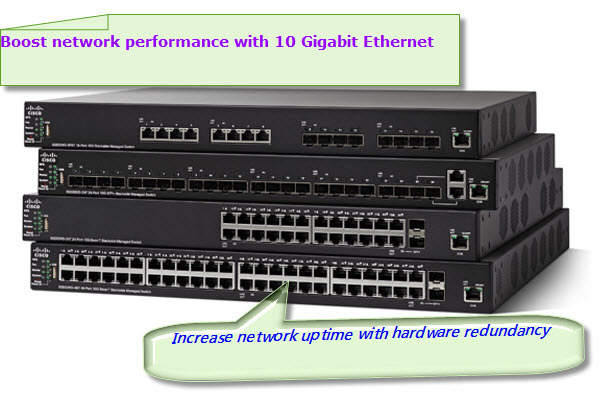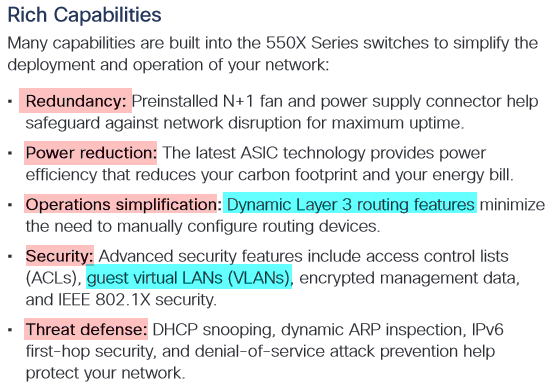
Cisco 550X Series Stackable Managed Switches, as its name said: the Stackable Managed Switches, they’re built with true stacking capability to support up to eight units and 384 ports in a single stack.
To get the fast data speeds, nonstop availability, and advanced security you need in your local-area network (LAN), you can turn to the Cisco 550X Series Stackable Managed Switches. These switches offer 16, 24, or 48 ports of 10 Gigabit Ethernet connections in both copper (10GBase-T) and fiber (SFP+) options, providing a solid foundation for your current business applications, as well as those you are planning for the future. At the same time, these switches are easy to deploy and manage, without a large IT staff.
Yes, Cisco 550X Series switches are built on 10 Gigabit Ethernet connectivity, giving you the speed you need to share information quickly.
These switches not only provide 10-Gbps connections for servers and storage devices, but also work as aggregation or core switches to provide a high-throughput backbone for your network.
They deliver substantial productivity gains today and help future proof your network for the demanding applications of tomorrow. The solution is simple to manage and supports advanced features traditionally reserved for large enterprises but now priced for small and midsized businesses
Cisco 550X Series Stackable Managed Switches Offer…Rich Capabilities
Some switches claim to support stacking but in practice support only “clustering,” meaning that each switch must still be managed and configured individually. Cisco 550 Series switches provide true stacking capability, allowing you to configure, manage, and troubleshoot all switches in a stack as a single unit; with a single IP address for up to a maximum of 48*8=384 10G Ethernet ports.
A true stack delivers a unified data and control plane, in addition to management plane, providing flexibility, scalability, and ease of use because the stack of units operates as a single entity constituting all the ports of the stack members. This capability can radically reduce complexity in a growing network environment while improving the resiliency and availability of network applications. True stacking also provides other cost savings and administrative benefits through features such as cross-stack QoS, VLANs, LAGs, and port mirroring, which clustered switches cannot support.
Using standard 10G fiber or copper connections, the Cisco 550 Series supports both local and horizontal stacking deployments and the flexibility of ring or chain topology. The switches also have the capability to use link aggregation port as the stacking port, providing even higher stacking bandwidth for demanding applications.
There are four main models of Cisco 550X Series: SG550XG-8F8T, SG550XG-24F, SG550XG-24T and SG550X-48T. What are the main differences between them? You can read the following comparison.
| Product | SG550XG-8F8T | SG550XG-24F | SG550XG-24T | SG550X-48T |
| Product ID | SG550XG-8F8T-K9 | SG550XG-24F-K9 | SG550XG-24T-K9 | SG550XG-48T-K9 |
| General | ||||
| Device type | Switch – 10-Gb – 16 ports – L3 – managed | Switch – 10-Gb – 24 ports – L3 – managed | Switch – 10-Gb – 24 ports – L3 – managed | Switch – 10-Gb – 48 ports – L3 – managed |
| Enclosure type | Rack-mountable – 1U | Rack-mountable – 1U | Rack-mountable – 1U | Rack-mountable – 1U |
| Ports | 8 10-Gb copper + 8 10-Gb SFP+ plus 1 GE OOB Management | 22 10-Gb SFP+ slots + 2 combo 10-Gb copper/SFP+ plus 1 GE OOB management | 22 10-Gb copper + 2 combo 10G copper/SFP+ plus 1 GE OOB management | 46 10-Gb copper + 2 combination 10-Gb copper/SFP+ plus 1 GE OOB management |
| Performance | Switching capacity: 320 Gbps Forwarding performance (64-byte packet size): 238.08 Mpps |
Switching capacity: 480 Gbps Forwarding performance (64-byte packet size): 357.12 Mpps |
Switching capacity: 480 Gbps Forwarding performance (64-byte packet size): 357.12 Mpps |
Switching capacity: 960 Gbps Forwarding performance (64-byte packet size): 714.24 Mpps |
| MAC address table size | 64,000 entries | 64,000 entries | 64,000 entries | 64,000 entries |
| Capacity | 4000 active VLANs | 4000 active VLANs | 4000 active VLANs | 4000 active VLANs |
| Routing protocol | RIPv2 + static IPv4/IPv6 routing | RIPv2 + static IPv4/IPv6 routing | RIPv2 + static IPv4/IPv6 routing | RIPv2 + static IPv4/IPv6 routing |
| RAM | 512 MB | 512 MB | 512 MB | 512 MB |
| Flash memory | 256 MB flash | 256 MB flash | 256 MB flash | 256 MB flash |
| Status indicators | System, Master, Fan, RPS, Stack ID, Link/Speed per port | System, Master, Fan, RPS, Stack ID, Link/Speed per port | System, Master, Fan, RPS, Stack ID, Link/Speed per port | System, Master, Fan, RPS, Stack ID, Link/Speed per port |
| Expansion and Connectivity | ||||
| Power | ||||
| Power device | Power supply – internal | Power supply – internal | Power supply – internal | Power supply – internal |
| Voltage required | AC 120/230 V (50/60 Hz) | AC 120/230 V ( 50/60 Hz) | AC 120/230 V (50/60 Hz) | AC 120/230 V (50/60 Hz) |
The more detailed comparison you can visit: https://www.cisco.com/c/en/us/products/switches/550x-series-stackable-managed-switches/compare-model.html
The NEW Cisco 550X Series switches provide true stacking, allowing you to configure, manage, and troubleshoot all switches in a stack as a single unit. Some competing switches claim to support stacking, but require you to configure and manage each switch individually.
If you wanna get more details of Cisco 550X Series Stackable Managed Switches, you can read its newest data sheet by visiting https://www.cisco.com/c/en/us/products/collateral/switches/550x-series-stackable-managed-switches/datasheet-c78-735874.html
More Related…
All about Cisco’s Stacking Switches
Compare Cisco Products and Solutions
Cisco Switch Stacking Using a Couple of Cisco Catalyst 3650
How to Upgrade the License from IP Base to IP Services on 3750-X Stack?




